Digital Twins for Climate-Responsive Urban Development: Integrating Zero-Energy Buildings into Smart City Strategies
Abstract
1. Introduction
2. Literature Review
3. Materials and Methods
- In response to climate change, how can the digital twin play a role in constructing zero-energy buildings?
- How can we achieve the maximum response to climate change through the use of digital twins to build zero-energy buildings?
- In order to achieve smart cities and zero-energy communities, what are the parameters that should be included in the design framework for using digital twins?
- -
- Research field: architecture, engineering, and construction (AEC)
- -
- Language: English
- -
- Publication date: 2014 to 2024
- -
- Type of work: scientific articles (scholarly journals)
- -
- Availability: full text
- -
- Subject: the role of using digital twins in net-zero-energy buildings in the housing sector as a response to climate change
- -
- Not belonging to the research field (AEC)
- -
- Not being in English
- -
- Publication before 2012
- -
- Not being a scientific article (scholarly journal)
- -
- Full text being unavailable
- -
- Not being related to the subject of interest
4. Result and Discussion
- -
- Energy efficiency optimization refers to the use of digital models to reduce energy waste by simulating and enhancing building system performance.
- -
- Renewable energy integration involves strategies that enable digital twins to facilitate the placement, sizing, and operation of solar, wind, or geothermal energy systems.
- -
- Design and retrofitting focus on how digital twins can inform energy-efficient decisions during the design or upgrade of buildings.
- -
- Real-time monitoring and control capture the ability of digital twins to use live data streams to manage and optimize energy usage dynamically.
- -
- Predictive maintenance involves anticipating failures and inefficiencies through machine learning and data analytics, improving operational performance.
- Energy efficiency optimization: Building systems can be modeled and simulated with digital twins, enabling energy savings and the optimization of energy consumption. The digital twin can monitor and analyze real-time data to identify inefficiencies and enhance energy efficiency by integrating real-time data from sensors and IoT devices [81].
- Renewable energy integration: Renewable energy sources can be integrated into building systems with the help of digital twins. Digital twins can optimize the placement, sizing, and operation of renewable energy technologies, such as solar panels, wind turbines, and geothermal systems, to maximize energy generation and minimize fossil fuel use.
- Design and retrofitting: In order to achieve net-zero-energy goals, digital twins can assist in the design and retrofitting of buildings. A digital twin can help architects and engineers to make informed decisions about building orientation, insulation, HVAC systems, and other energy-efficient features, by simulating different design scenarios and evaluating their energy performance. In this way, energy consumption is optimized throughout the lifecycle of the building.
- Real-time monitoring and control: The real-time monitoring and control of building systems is enabled by digital twins. With the integration of data from sensors, meters, and energy-management systems, digital twins can reveal energy usage patterns, detect anomalies, and enable proactive energy management. As a result, energy efficiency can be maintained, and areas for improvement can be identified [82].
- Predictive maintenance: To enhance energy efficiency, digital twins can support predictive maintenance strategies. Digital twins can predict equipment failures, optimize maintenance schedules and prevent energy waste due to malfunctioning systems, by analyzing real-time data and using machine learning algorithms. The energy efficiency of buildings is improved as a result.
ZEBs as Pillars of Smart City Development
5. Future Work
- Designing and implementing machine learning algorithms that predict building energy behavior in response to dynamic climatic and occupancy conditions.
- Integrating real-time sensor networks with cloud-based digital twin platforms, enabling adaptive control strategies and energy optimization in zero-energy buildings.
- Developing modular simulation models tailored to different building types and urban morphologies, particularly in hot–arid regions like the Middle East.
- Assessing the computational performance and scalability of these models across neighborhood or city-wide digital twin platforms.
- Exploring the use of generative design algorithms in tandem with digital twins to simulate retrofitting or energy upgrade scenarios for existing building stock.
6. Conclusions
Funding
Institutional Review Board Statement
Informed Consent Statement
Data Availability Statement
Conflicts of Interest
References
- Ricciardi, G.; Callegari, G. Digital Twins for Climate-Neutral and Resilient Cities. In State of the Art and Future Development as Tools to Support Urban Decision-Making; The Urban Book, Series; Arbizzani, E., Cangelli, E., Clemente, C., Cumo, F., Giofrè, F., Giovenale, A.M., Palme, M., Paris, S., Eds.; Springer: Cham, Switzerland, 2023; pp. 617–626. [Google Scholar] [CrossRef]
- Singh, M.; Fuenmayor, E.; Hinchy, E.; Qiao, Y.; Murray, N.; Devine, D. Digital Twin: Origin to future. Appl. Syst. Innov. 2021, 4, 36. [Google Scholar] [CrossRef]
- Bortolini, R.; Rodrigues, R.; Alavi, H.; Vecchia, L.F.D.; Forcada, N. Digital Twins’ Applications for building Energy Efficiency: A review. Energies 2022, 15, 7002. [Google Scholar] [CrossRef]
- Weil, C.; Bibri, S.E.; Longchamp, R.; Golay, F.; Alahi, A. Urban Digital Twin Challenges: A Systematic Review and Perspectives for Sustainable Smart Cities. Sustain. Cities Soc. 2023, 99, 104862. [Google Scholar] [CrossRef]
- Pörtner, H.; Roberts, D.C.; Tignor, M.; Poloczanska, E.S.; Mintenbeck, K.; Alegría, A.; Craig, M.; Langsdorf, S.; Löschke, S.; Möller, V.; et al. Climate Change 2022: Impacts, Adaptation, and Vulnerability; Contribution of Working Group II to the Sixth Assessment Report of the Intergovernmental Panel on Climate Change; IPCC: Cambridge, UK; New York, NY, USA, 2022. [Google Scholar] [CrossRef]
- Panagiotidou, M.; Fuller, R.J. Progress in ZEBs—A review of definitions, policies and construction activity. Energy Policy 2013, 62, 196–206. [Google Scholar] [CrossRef]
- Deng, T.; Zhang, K.; Shen, Z. A systematic review of a digital twin city: A new pattern of urban governance toward smart cities. J. Manag. Sci. Eng. 2021, 6, 125–134. [Google Scholar] [CrossRef]
- Grieves, M.; Vickers, J. Digital Twin: Mitigating unpredictable, undesirable emergent behavior in complex systems. In Transdisciplinary Perspectives on Complex Systems; Springer eBooks; Springer: Berlin/Heidelberg, Germany, 2016; pp. 85–113. [Google Scholar] [CrossRef]
- Shafto, M.; Conroy, M.; Doyle, R.; Glaessgen, E.; Kemp, C.; LeMoigne, J.; Wang, L. DRAFT MoDeling, SiMulATion, inFoRMATion T echnology & PRoceSSing RoADMAP Technology Area 11. In National Aeronautics and Space Administration. 2010. Available online: https://www.emacromall.com/reference/NASA-Modeling-Simulation-IT-Processing-Roadmap.pdf (accessed on 16 July 2025).
- Ferré-Bigorra, J.; Casals, M.; Gangolells, M. The adoption of urban digital twins. Cities 2022, 131, 103905. [Google Scholar] [CrossRef]
- Study, C.A.T. Chicago Area Transportation Study. Final Report. Volume III. 1962. Available online: https://cmap.illinois.gov/wp-content/uploads/CATS_plan_1962.pdf (accessed on 16 July 2025).
- Wan, L.; Nochta, T.; Schooling, J.M. Developing a City-Level digital twin–Propositions and a case study. In Proceedings of the International Conference on Smart Infrastructure and Construction 2019, ICSIC 2019: Driving Data-Informed Decision-Making, Cambridge, UK, 8–10 July 2019; pp. 187–194. [Google Scholar] [CrossRef]
- EC. EU Strategy on Adaptation to Climate Change. COM/2021/82 Final. 2021. Available online: https://climate.ec.europa.eu/eu-action/adaptation-and-resilience-climate-change/eu-adaptation-strategy_en#:~:text=The%20new%20strategy%20sets%20out,on%20adaptation%20to%20climate%20change (accessed on 16 July 2025).
- Henriksen, H.; Schneider, R.; Koch, J.; Ondracek, M.; Troldborg, L.; Seidenfaden, I.; Kragh, S.; Bøgh, E.; Stisen, S. A new digital twin for climate change adaptation, water management, and disaster Risk reduction (HIP digital twin). Water 2022, 15, 25. [Google Scholar] [CrossRef]
- Huang, H.; Tsou, J.Y. From Concept to Reality: A Systematic Review of Urban Digital Twin and Their Applications in Smart Cities. In Advances in Information Technology in Civil and Building Engineering. ICCCBE 2024; Lecture Notes in Civil, Engineering; Francis, A., Miresco, E., Melhado, S., Eds.; Springer: Cham, Switzerland, 2025; Volume 628. [Google Scholar] [CrossRef]
- Engin, Z.; Van Dijk, J.; Lan, T.; Longley, P.A.; Treleaven, P.; Batty, M.; Penn, A. Data-driven urban management: Mapping the landscape. J. Urban Manag. 2019, 9, 140–150. [Google Scholar] [CrossRef]
- Batty, M. Fifty Years of Urban Modeling: Macro-Statics to Micro-Dynamics. In The Dynamics of Complex Urban Systems; Physica-Verlag HD: Heidelberg, Germany, 2007; pp. 1–20. [Google Scholar] [CrossRef]
- Li, X.; Luo, J.; Li, Y.; Wang, W.; Hong, W.; Liu, M.; Li, X.; Lv, Z. Application of effective water-energy management based on digital twins technology in sustainable cities construction. Sustain. Cities Soc. 2022, 87, 104241. [Google Scholar] [CrossRef]
- Caprari Caprari, G.; Castelli, G.; Montuori, M.; Camardelli, M.; Malvezzi, R. Digital Twin for urban planning in the Green Deal Era: A state of the art and future perspectives. Sustainability 2022, 14, 6263. [Google Scholar] [CrossRef]
- Cudzik, J.; Aydoğan, M.; Güler, B.E. Level of detail categorization for the application in urban design. Przestrz. Forma 2023, 2023, 9–27. [Google Scholar] [CrossRef]
- Bibri, S.E. Data-Driven Smart Sustainable Cities of the Future: New conceptions of and approaches to the spatial scaling of urban form. Futur. Cities Environ. 2021, 7, 15. [Google Scholar] [CrossRef]
- Kubberød, E. The Emergence of Digital Twin Technology in Urban Planning: A study of Perceptions, Opportunities and Barriers. Master’s Thesis, Norwegian University of Life Sciences, As, Norway, 2023. Available online: https://hdl.handle.net/11250/3078973 (accessed on 16 July 2025).
- Bujari, A.; Calvio, A.; Foschini, L.; Sabbioni, A.; Corradi, A. A digital twin decision support system for the urban facility management process. Sensors 2021, 21, 8460. [Google Scholar] [CrossRef] [PubMed]
- Ziehl, M.; Herzog, R.; Degkwitz, T.; Niggemann, M.H.; Ziemer, G.; Thoneick, R. Transformative research in digital twins for Integrated Urban Development. Int. J. E-Plan. Res. 2023, 12, 1–18. [Google Scholar] [CrossRef]
- Akroyd, J.; Harper, Z.; Soutar, D.; Farazi, F.; Bhave, A.; Mosbach, S.; Kraft, M. Universal Digital Twin: Land use. Data-Centric Eng. 2022, 3, e3. [Google Scholar] [CrossRef]
- Bauer, M.; Cirillo, F.; Fürst, J.; Solmaz, G.; Kovacs, E. Urban Digital Twins—A FIWARE-based model. at—Autom. 2021, 69, 1106–1115. [Google Scholar] [CrossRef]
- White, G.; Zink, A.; Codecá, L.; Clarke, S. A digital twin smart city for citizen feedback. Cities 2021, 110, 103064. [Google Scholar] [CrossRef]
- De Wilde, P. Building performance simulation in the brave new world of artificial intelligence and digital twins: A systematic review. Energy Build. 2023, 292, 113171. [Google Scholar] [CrossRef]
- Francisco, A.; Asce, S.M.; Mohammadi, N.; Asce, A.M.; Taylor, J.E.; Asce, M. Smart City Digital Twin–Enabled Energy Management: Toward Real-Time Urban Building Energy Benchmarking. J. Manag. Eng. 2020, 36, 04019045. [Google Scholar] [CrossRef]
- Paiho, S.; Wessberg, N.; Dubovik, M.; Lavikka, R.; Naumer, S. Twin transition in the built environment—Policy mechanisms, technologies and market views from a cold climate perspective. Sustain. Cities Soc. 2023, 98, 104870. [Google Scholar] [CrossRef]
- Arowoiya, V.A.; Moehler, R.C.; Fang, Y. Digital twin technology for thermal comfort and energy efficiency in buildings: A state-of-the-art and future directions. Energy Built Environ. 2023, 5, 641–656. [Google Scholar] [CrossRef]
- Billey, A.; Wuest, T. Energy digital twins in smart manufacturing systems: A case study. Robot. Comput.-Integr. Manuf. 2024, 88, 102729. [Google Scholar] [CrossRef]
- Ford, D.N.; Wolf, C.M. Smart Cities with Digital Twin Systems for Disaster Management. J. Manag. Eng. 2020, 36, 04020027. [Google Scholar] [CrossRef]
- Lauria, M.; Azzalin, M. Digital Twin approach for maintenance management. In The Urban Book Series; Springer: Cham, Switzerland, 2023; pp. 237–246. [Google Scholar] [CrossRef]
- Tomko, M.; Winter, S. Beyond digital twins—A commentary. Environ. Plan. B Urban Anal. City Sci. 2018, 46, 395–399. [Google Scholar] [CrossRef]
- Çetin, S.; De Wolf, C.; Bocken, N. Circular Digital Built Environment: An emerging framework. Sustainability 2021, 13, 6348. [Google Scholar] [CrossRef]
- Brasil, J.A.T.; De Macedo, M.B.; De Oliveira, T.R.P.; Ghiglieno, F.G.; De Souza, V.C.B.; Silva, G.M.E.; Júnior, M.N.G.; De Souza, F.A.A.; Mendiondo, E.M. Can we scale Digital Twins of Nature-based Solutions for stormwater and transboundary water security projects? J. Hydroinformatics 2022, 24, 749–764. [Google Scholar] [CrossRef]
- Ramu, S.P.; Boopalan, P.; Pham, Q.; Maddikunta, P.K.R.; Huynh-The, T.; Alazab, M.; Nguyen, T.T.; Gadekallu, T.R. Federated learning enabled digital twins for smart cities: Concepts, recent advances, and future directions. Sustain. Cities Soc. 2022, 79, 103663. [Google Scholar] [CrossRef]
- Alva, P.; Mosteiro-Romero, M.; Miller, C.; Stouffs, R. Digital Twin-Based Resilience Evaluation of District-Scale archetypes. In Proceedings of the International Conference on Computer-Aided Architectural Design Research in Asia, Sydney, Australia, 9–15 April 2022. [Google Scholar] [CrossRef]
- Singh, M.; Srivastava, R.; Fuenmayor, E.; Kuts, V.; Qiao, Y.; Murray, N.; Devine, D. Applications of Digital Twin across Industries: A Review. Appl. Sci. 2022, 12, 5727. [Google Scholar] [CrossRef]
- Hu, W.; Lim, K.Y.H.; Cai, Y. Digital Twin and Industry 4.0 Enablers in Building and Construction: A Survey. Buildings 2022, 12, 2004. [Google Scholar] [CrossRef]
- Wang, K.; Guo, F. Towards Sustainable Development through the Perspective of Construction 4.0: Systematic Literature Review and Bibliometric Analysis. Buildings 2022, 12, 1708. [Google Scholar] [CrossRef]
- Fouquet, R.; Hippe, R. Twin transitions of decarbonisation and digitalisation: A historical perspective on energy and information in European economies. Energy Res. Soc. Sci. 2022, 91, 102736. [Google Scholar] [CrossRef]
- Broo, D.G.; Lamb, K.; Ehwi, R.J.; Pärn, E.; Koronaki, A.; Makri, C.; Zomer, T. Built environment of Britain in 2040: Scenarios and strategies. Sustain. Cities Soc. 2020, 65, 102645. [Google Scholar] [CrossRef]
- Debrah, C.; Chan, A.P.; Darko, A. Artificial intelligence in green building. Autom. Constr. 2022, 137, 104192. [Google Scholar] [CrossRef]
- Luusua, A.; Ylipulli, J.; Foth, M.; Aurigi, A. Urban AI: Understanding the emerging role of artificial intelligence in smart cities. AI Soc. 2022, 38, 1039–1044. [Google Scholar] [CrossRef] [PubMed]
- Filho, W.L.; Wall, T.; Mucova Sa, R.; Nagy, G.J.; Balogun, A.; Luetz, J.M.; Ng, A.W.; Kovaleva, M.; Azam, F.M.S.; Alves, F.; et al. Deploying artificial intelligence for climate change adaptation. Technol. Forecast. Soc. Change 2022, 180, 121662. [Google Scholar] [CrossRef]
- Das, H.P.; Lin, Y.-W.; Agwan, U.; Spangher, L.; Devonport, A.; Yang, Y.; Drgoňa, J.; Chong, A.; Schiavon, S.; Spanos, C.J. Machine learning for smart and Energy-Efficient buildings. Environ. Data Sci. 2024, 3, e1. [Google Scholar] [CrossRef]
- Yang, B.; Lv, Z.; Wang, F. Digital twins for intelligent green buildings. Buildings 2022, 12, 856. [Google Scholar] [CrossRef]
- Adu-Amankwa, N.A.N.; Rahimian, F.P.; Dawood, N.; Park, C. Digital Twins and Blockchain technologies for building lifecycle management. Autom. Constr. 2023, 155, 105064. [Google Scholar] [CrossRef]
- Bibri, S.E. Data-driven smart sustainable cities of the future: An evidence synthesis approach to a comprehensive state-of-the-art literature review. Sustain. Futures 2021, 3, 100047. [Google Scholar] [CrossRef]
- Hämäläinen, M. A framework for a smart city design: Digital Transformation in the Helsinki Smart City. In Entrepreneurship and the Community; Contributions to Management Science; Springer: Cham, Switzerland, 2019; pp. 63–86. [Google Scholar] [CrossRef]
- Bibri, S.E.; Huang, J.; Omar, O.; Kenawy, I. Synergistic integration of digital twins and zero energy buildings for climate change mitigation in sustainable smart cities: A systematic review and novel framework. Energy Build. 2025, 333, 115484. [Google Scholar] [CrossRef]
- Park, J.; Choi, W.; Jeong, T.; Seo, J. Digital twins and land management in South Korea. Land Use Policy 2022, 124, 106442. [Google Scholar] [CrossRef]
- Laag-Yamu, V.D.; Tan, W.; Sielker, F. Demystifying urban digital twins: Evaluating the case of Herrenberg through the lens of the Gemini and FAIR data Principles. In Digital Twins for Smart Cities: Conceptualisation, Challenges and Practices; ICE Publishing: London, UK, 2023; pp. 29–30. [Google Scholar] [CrossRef]
- Allam, Z.; Jones, D.S. Future (post-COVID) digital, smart and sustainable cities in the wake of 6G: Digital twins, immersive realities and new urban economies. Land Use Policy 2020, 101, 105201. [Google Scholar] [CrossRef]
- Deprêtre, A.; Jacquinod, F.; Mielniczek, A. Exploring digital twin adaptation to the urban environment: Comparison with cim to avoid silo-based approaches. In ISPRS Annals of the Photogrammetry, Remote Sensing and Spatial Information Sciences; Copernicus GmbH: Göttingen, Germany, 2022; Volume V-4–2022, pp. 337–344. [Google Scholar] [CrossRef]
- Schrotter, G.; Hürzeler, C. The digital twin of the City of Zurich for urban planning. PFG—J. Photogramm. Remote Sens. Geoinf. Sci. 2020, 88, 99–112. [Google Scholar] [CrossRef]
- Deren, L.; Wenbo, Y.; Zhenfeng, S. Smart city based on digital twins. Comput. Urban Sci. 2021, 1, 4. [Google Scholar] [CrossRef]
- Bibri, S.E. Data-driven smart sustainable cities of the future: Urban computing and intelligence for strategic, short-term, and joined-up planning. Comput. Urban Sci. 2021, 1, 8. [Google Scholar] [CrossRef]
- Bologna, R.; Hasanaj, G. A systematic catalogue of design solutions for the regeneration of urban environment contrasting the climate change impact. In The Urban Book Series; Arbizzani, E., Cangelli, E., Clemente, C., Cumo, F., Giofrè, F., Giovenale, A.M., Palme, M., Paris, S., Eds.; Springer: Cham, Switzerland, 2023; pp. 601–616. [Google Scholar] [CrossRef]
- Bibri, S.E.; Alexandre, A.; Sharifi, A.; Krogstie, J. Environmentally sustainable smart cities and their converging AI, IoT, and big data technologies and solutions: An integrated approach to an extensive literature review. Energy Inform. 2023, 6, 9. [Google Scholar] [CrossRef] [PubMed]
- Shao, J.; Min, B. Sustainable development strategies for Smart Cities: Review and development framework. Cities 2024, 158, 105663. [Google Scholar] [CrossRef]
- Mäkitie, T.; Hanson, J.; Damman, S.; Wardeberg, M. Digital innovation’s contribution to sustainability transitions. Technol. Soc. 2023, 73, 102255. [Google Scholar] [CrossRef]
- Huang, W.; Zhang, Y.; Zeng, W. Development and application of digital twin technology for integrated regional energy systems in smart cities. Sustain. Comput. Inform. Syst. 2022, 36, 100781. [Google Scholar] [CrossRef]
- Jeddoub, I.; Nys, G.; Hajji, R.; Billen, R. Digital Twins for cities: Analyzing the gap between concepts and current implementations with a specific focus on data integration. Int. J. Appl. Earth Obs. Geoinf. 2023, 122, 103440. [Google Scholar] [CrossRef]
- Batty, M. Digital twins. Environ. Plan. B Urban Anal. City Sci. 2018, 45, 817–820. [Google Scholar] [CrossRef]
- Rajabifard, A.; Sabri, S.; Chen, Y. Digital Twin for the Next Generation of Urban Land Administration and 3D Spatial Planning. In Proceedings of the FIG Congress 2022, Volunteering for the future—Geospatial Excellence for a Better Living, Warsaw, Poland, 11–15 September 2022. [Google Scholar]
- Hoffmann, J.; Bauer, P.; Sandu, I.; Wedi, N.; Geenen, T.; Thiemert, D. Destination Earth—A digital twin in support of climate services. Clim. Serv. 2023, 30, 100394. [Google Scholar] [CrossRef]
- Pigola, A.; Da Costa, P.R.; Carvalho, L.C.; Da Silva, L.F.; Kniess, C.T.; Maccari, E.A. Artificial Intelligence-Driven Digital Technologies to the Implementation of the Sustainable Development Goals: A Perspective from Brazil and Portugal. Sustainability 2021, 13, 13669. [Google Scholar] [CrossRef]
- Liu, Z.; Li, P.; Wang, F.; Osmani, M.; Demian, P. Building Information Modeling (BIM) Driven Carbon Emission Reduction Research: A 14-Year Bibliometric Analysis. Int. J. Environ. Res. Public Health 2022, 19, 12820. [Google Scholar] [CrossRef] [PubMed]
- Naserentin, V.; Somanath, S.; Eleftheriou, O.; Logg, A. Combining open source and commercial tools in digital Twin for cities generation. IFAC-Pap. 2022, 55, 185–189. [Google Scholar] [CrossRef]
- Arsiwala, A.; Elghaish, F.; Zoher, M. Digital twin with Machine learning for predictive monitoring of CO2 equivalent from existing buildings. Energy Build. 2023, 284, 112851. [Google Scholar] [CrossRef]
- Langenheim, N.; Sabri, S.; Chen, Y.; Kesmanis, A.; Felson, A.; Mueller, A.; Rajabifard, A.; Zhang, Y. Adapting a digital twin to enable real-time water sensitive urban design decision-making. In Proceedings of the International Archives of the Photogrammetry, Remote Sensing and Spatial Information Sciences/International Archives of the Photogrammetry, Remote Sensing and Spatial Information Sciences, XLVIII-4/W4-2022, Sydney, Australia, 19–21 October 2022; pp. 95–100. [Google Scholar] [CrossRef]
- Dervishaj, A. From Sustainability to Regeneration: A digital framework with BIM and computational design methods. Archit. Struct. Constr. 2023, 3, 315–336. [Google Scholar] [CrossRef]
- Dembski, F.; Wössner, U.; Letzgus, M.; Ruddat, M.; Yamu, C. Urban Digital twins for smart cities and citizens: The case study of Herrenberg, Germany. Sustainability 2020, 12, 2307. [Google Scholar] [CrossRef]
- Yu, W.; Patros, P.; Young, B.; Klinac, E.; Walmsley, T.G. Energy digital twin technology for industrial energy management: Classification, challenges and future. Renew. Sustain. Energy Rev. 2022, 161, 112407. [Google Scholar] [CrossRef]
- O’Dwyer, E.; Pan, I.; Charlesworth, R.; Butler, S.; Shah, N. Integration of an energy management tool and digital twin for coordination and control of multi-vector smart energy systems. Sustain. Cities Soc. 2020, 62, 102412. [Google Scholar] [CrossRef]
- Botín-Sanabria, D.M.; Mihaita, A.; Peimbert-García, R.E.; Ramírez-Moreno, M.A.; Ramírez-Mendoza, R.A.; De JLozoya-Santos, J. Digital Twin Technology Challenges and Applications: A Comprehensive review. Remote Sens. 2022, 14, 1335. [Google Scholar] [CrossRef]
- IEA. World Energy Outlook 2021; IEA: Paris, France, 2021; Available online: https://www.iea.org/reports/world-energy-outlook-2021 (accessed on 16 July 2025).
- El-Gohary, M.; El-Abed, R.; Omar, O. Prediction of an efficient Energy-Consumption model for existing residential buildings in Lebanon Using an artificial neural network as a digital twin in the era of climate change. Buildings 2023, 13, 3074. [Google Scholar] [CrossRef]
- Bibri, S.E.; Huang, J.; Omar, O. Leveraging Digital Twins for Zero-Energy Building Ratings in Sustainable Smart Cities: A Comprehensive Review and Novel Framework. In Digital Twins for Smart Metabolic Circular Cities: Innovations in Planning and Climate Resilience; Bibri, S.E., Yigitcanlar, S.E.T., Huang, J., Eds.; Smart Cities Book Series; Elsevier: London, UK, 2025; ISBN 9780443333330. [Google Scholar] [CrossRef]
- Omar, O. Intelligent systems for functional improvement of buildings. Int. J. Environ. Sci. Dev. 2020, 11, 244–250. [Google Scholar] [CrossRef]
- Ibrahim, M.A.; Hanafi, M.A.; Omar, O.M. Nanoarchitecture and Global Warming; Alexandria University: Alexandria, Egypt, 2010. [Google Scholar]
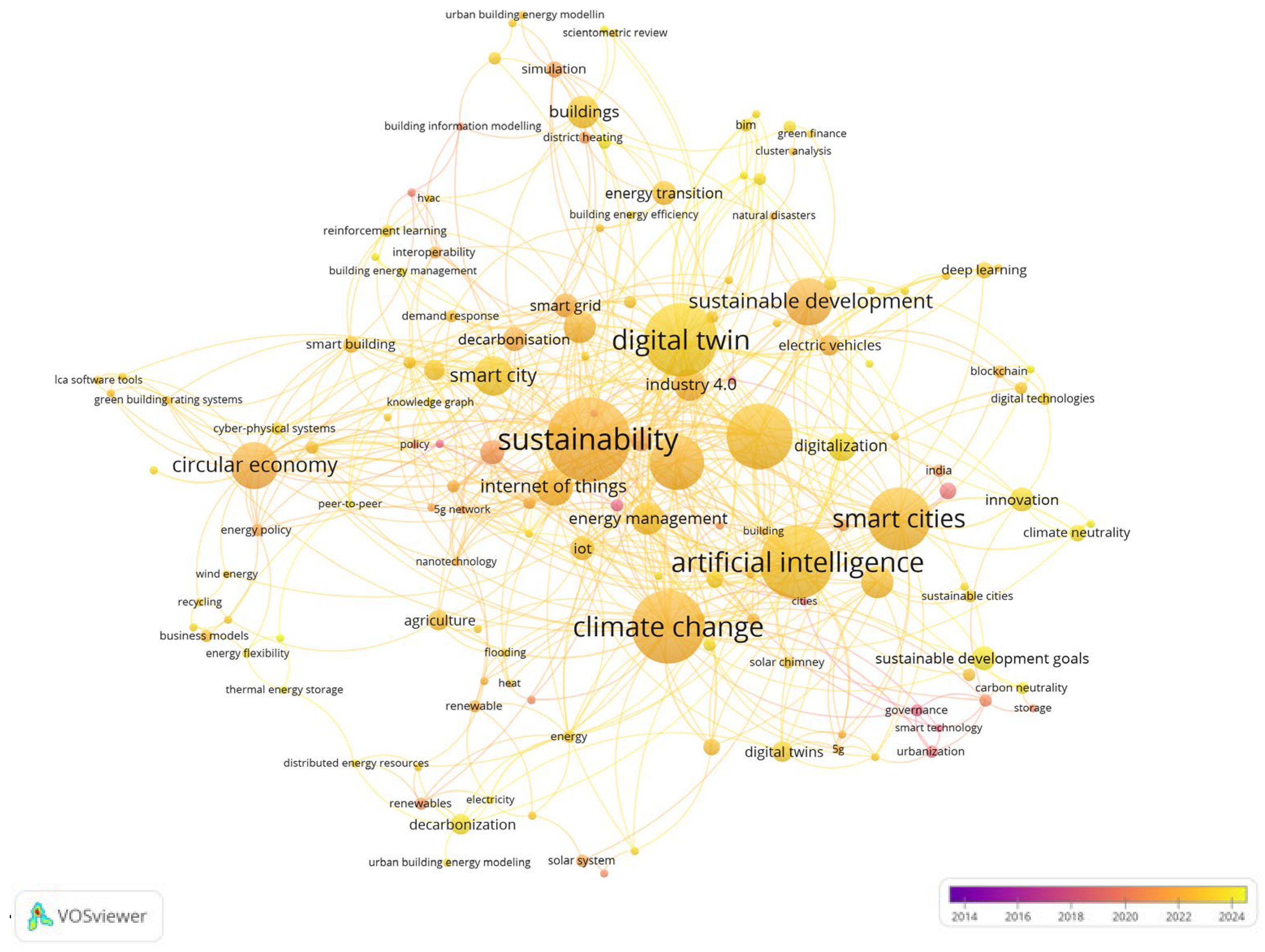
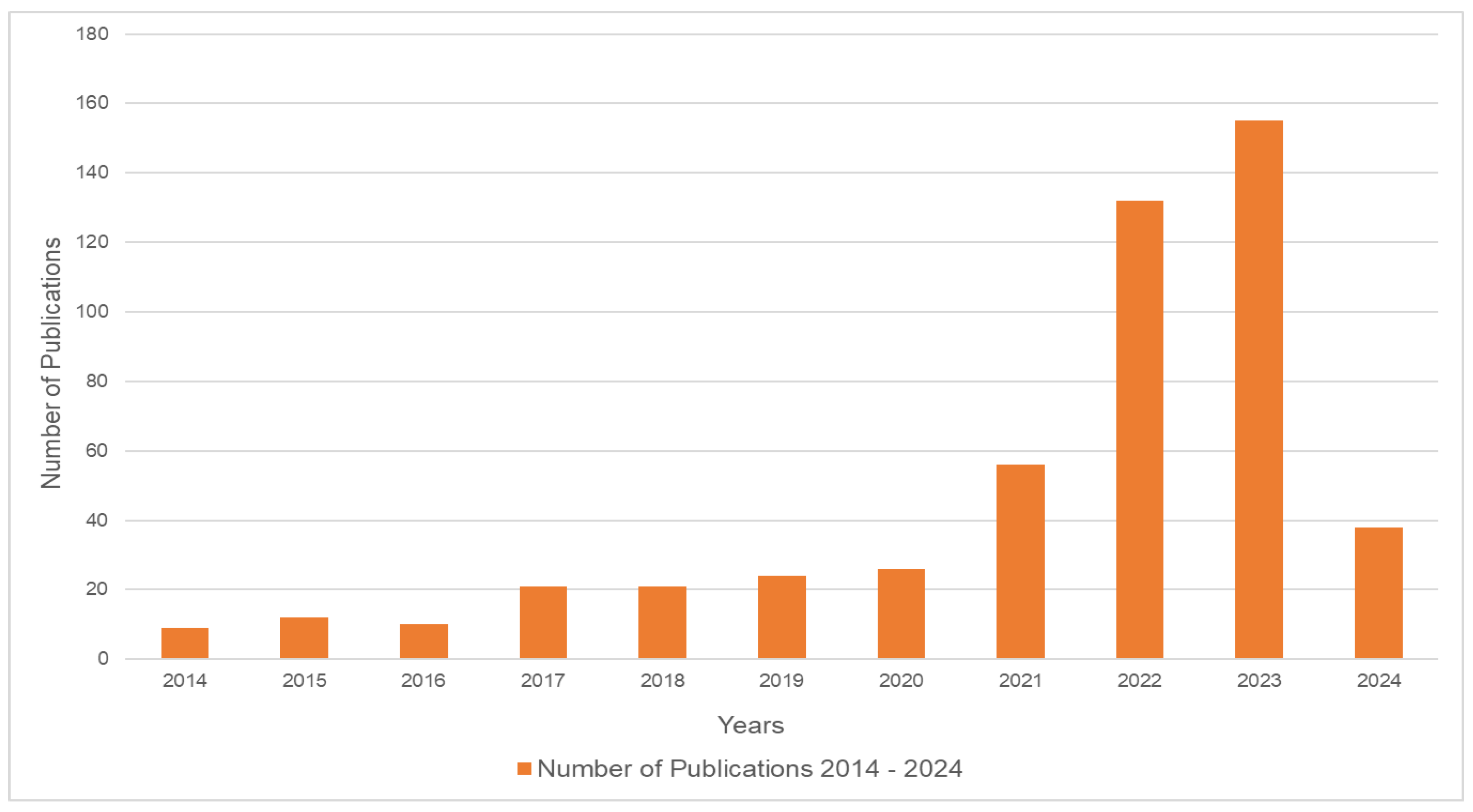
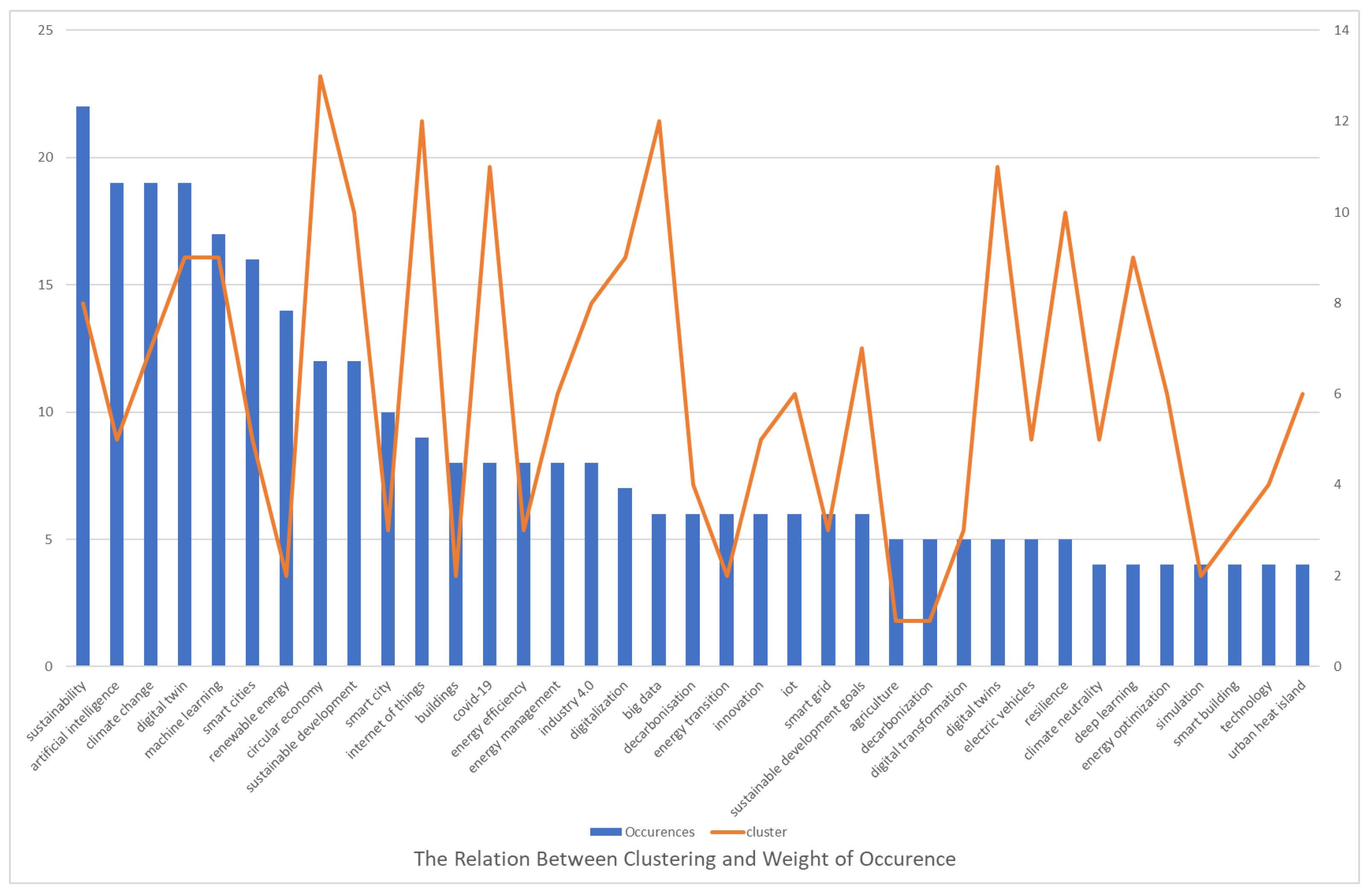
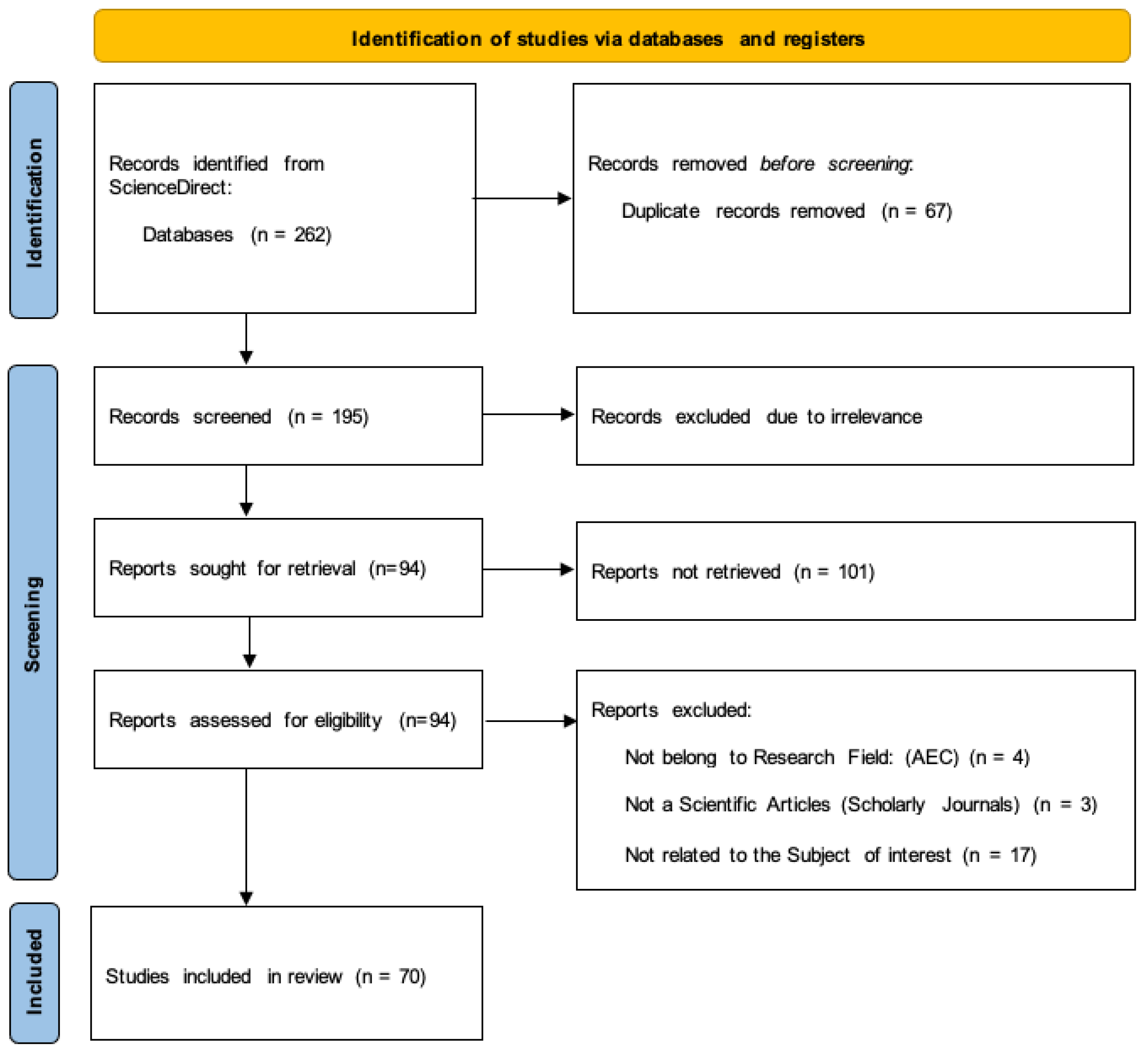
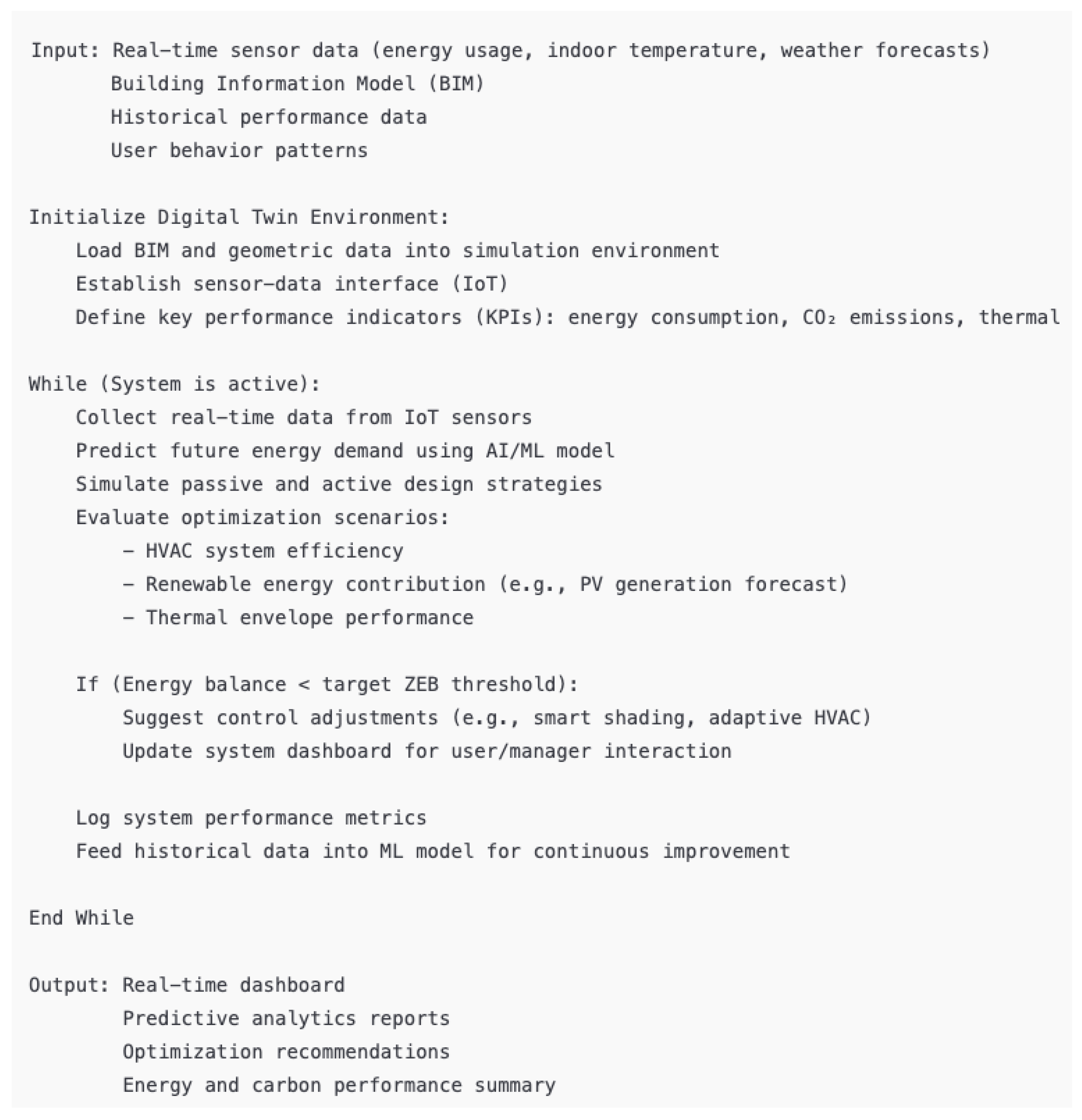
| Thematic Cluster | Topic (Ref.) |
|---|---|
| Digital Twin Applications | Urban digital twins [10,15,16,17,18,19,20,21,22,23,24,25,26] |
| Digital twin cities [27] | |
| DT and building performance simulation [3,28,29,30,31,32] | |
| DT for disaster management [33] | |
| DT in the operation and maintenance phase [34] | |
| DT and metaphor [35] | |
| DT and the circular economy [36] | |
| DT and nature-based solutions [37] | |
| Occupant behaviors and DT management [38] | |
| Resilience assessment and DT [39] | |
| DT in industries [40,41,42,43] | |
| DT and built environments [44]; | |
| AI and Smart Technologies | AI in green buildings [45,46] |
| AI and climate change [47,48] | |
| DT and intelligent green buildings [49] | |
| DT and blockchain [50] | |
| Urban Sustainability Strategies | Smart sustainable cities and DT [51,52,53,54,55,56,57,58,59,60] |
| Building climate-neutral and resilient cities [1] | |
| DT and climate change adaptation [61] | |
| Digitalization and decarbonization [62,63] | |
| DT and sustainability transitions [64] | |
| DT and energy systems on an urban scale [65]; | |
| Integration Frameworks | Definitions of digital twins [2,66,67,68,69] |
| DT integration with IoT, BIM, GIS, big data, and AI [12,60,70,71,72,73,74,75,76] | |
| Energy (DT) across the lifecycle and carbon emissions [77,78,79] |
| N. | Topics Discussed in Selected Articles | Digital Twins: Five Indicators in Response to Climate Change | Ref. No. From Table 1 | ||||
|---|---|---|---|---|---|---|---|
| Energy Efficiency Optimization | Renewable Energy Integration | Design and Retrofitting | Real-Time Monitoring and Control | Predictive Maintenance | |||
| 1 | Urban digital twins (UDT) | √ | √ | √ | [10,15,16,17,18,19,20,21,22,23,24,25,26] | ||
| 2 | Smart sustainable cities and DT | √ | √ | √ | √ | √ | [51,52,53,54,55,56,57,58,59,60] |
| 3 | DT and building performance simulation (thermal comfort, energy efficiency, and energy consumption) | √ | √ | √ | [3,28,29,30,31,32] | ||
| 4 | AI in green buildings | √ | √ | √ | √ | [45] | |
| 5 | Definitions of digital twins (DT) | √ | √ | √ | [2,66,67,68,69] | ||
| 6 | Digital twin cities (DTC) | √ | √ | √ | [27] | ||
| 7 | DT for disaster management | √ | √ | √ | √ | [33] | |
| 8 | DT in the operation and maintenance phase | √ | √ | √ | √ | [34] | |
| 9 | DT and climate change adaptation | √ | √ | √ | √ | [61] | |
| 10 | Building climate-neutral and resilient cities with UDT | √ | √ | √ | [1] | ||
| 11 | DT in industries | √ | √ | √ | √ | [40,41,42,43] | |
| 12 | Digital twins and built environments | √ | √ | √ | √ | √ | [44] |
| 13 | Resilience assessment and DT | √ | √ | √ | [39] | ||
| 14 | DT and the circular economy | √ | √ | √ | √ | [36] | |
| 15 | AI and climate change | √ | √ | √ | √ | √ | [47,48] |
| 16 | DT and energy systems on an urban scale | √ | √ | √ | [65] | ||
| 17 | DT and metaphor | √ | √ | [35] | |||
| 18 | DT and intelligent green buildings | √ | √ | √ | √ | √ | [49] |
| 19 | DT and sustainability transitions | √ | √ | √ | [64] | ||
| 20 | DT integration with IoT, BIM, GIS, big data, and AI | √ | √ | √ | √ | [12,60,70,71,72,73,74,75,76] | |
| 21 | DT and blockchain | √ | √ | ||||
| 22 | Energy (DT) across the lifecycle and carbon emissions | √ | √ | √ | √ | √ | |
| 23 | Digitalization and decarbonization | √ | √ | √ | √ | [62,63] | |
| 24 | Occupant behaviors and DT management | √ | √ | √ | [38] | ||
| 25 | DT and nature-based solutions | √ | √ | [37] | |||
| The Correlation Between Digital Twins, Smart Cities, and Zero-Energy Buildings as a Response to Climate Change | ||||
|---|---|---|---|---|
| Design and retrofitting for zero-energy buildings | Aspect 1: Digital twins and building performance | Climate change adaptation and mitigation strategies | ||
| A-Real-time monitoring and control phase | Stakeholders and the private sector | |||
| a.1. Energy efficiency optimization (efficient lighting systems, etc.) | ||||
| a.2. Passive heating and cooling strategies | ||||
| a.3. Energy-efficient equipment and utilities | ||||
| a.4. Water management | ||||
| B-Operation and maintenance phase | ||||
| b.1. Building envelope | ||||
| b.2. Waste management | ||||
| b.3. Lifecycle assessment | ||||
| b.4. Optimization based on occupancy level | ||||
| Smart cities | Aspect 2: Urban digital twins | |||
| A-Climate change adaptation | Government organization | |||
| B-Disaster management | ||||
| C-Digital twins and nature-based solutions | ||||
| Sustainable energy production | Aspect 2: Digital twins and renewable energy production | |||
| A-Renewable energy integration | Investors | |||
| B-Predictive maintenance | ||||
Disclaimer/Publisher’s Note: The statements, opinions and data contained in all publications are solely those of the individual author(s) and contributor(s) and not of MDPI and/or the editor(s). MDPI and/or the editor(s) disclaim responsibility for any injury to people or property resulting from any ideas, methods, instructions or products referred to in the content. |
© 2025 by the author. Licensee MDPI, Basel, Switzerland. This article is an open access article distributed under the terms and conditions of the Creative Commons Attribution (CC BY) license (https://creativecommons.org/licenses/by/4.0/).
Share and Cite
Omar, O. Digital Twins for Climate-Responsive Urban Development: Integrating Zero-Energy Buildings into Smart City Strategies. Sustainability 2025, 17, 6670. https://doi.org/10.3390/su17156670
Omar O. Digital Twins for Climate-Responsive Urban Development: Integrating Zero-Energy Buildings into Smart City Strategies. Sustainability. 2025; 17(15):6670. https://doi.org/10.3390/su17156670
Chicago/Turabian StyleOmar, Osama. 2025. "Digital Twins for Climate-Responsive Urban Development: Integrating Zero-Energy Buildings into Smart City Strategies" Sustainability 17, no. 15: 6670. https://doi.org/10.3390/su17156670
APA StyleOmar, O. (2025). Digital Twins for Climate-Responsive Urban Development: Integrating Zero-Energy Buildings into Smart City Strategies. Sustainability, 17(15), 6670. https://doi.org/10.3390/su17156670






